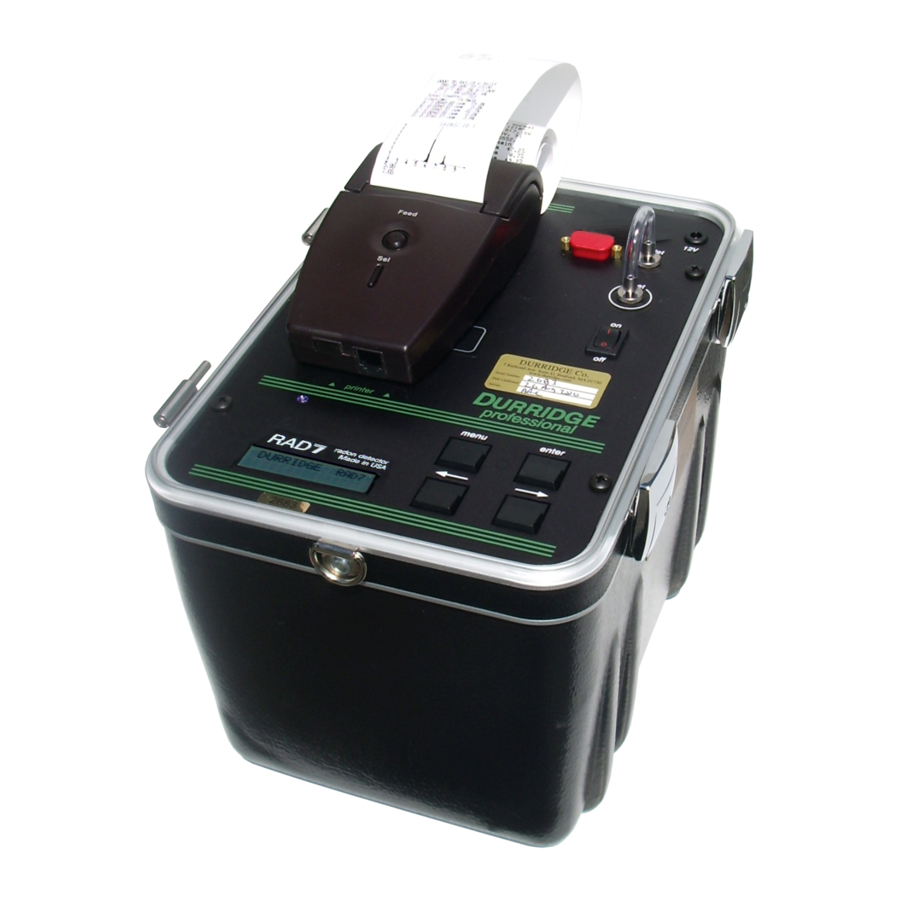DURRIDGE RAD7 Kullanıcı Kılavuzu - Sayfa 7
Güvenlik Sensörleri DURRIDGE RAD7 için çevrimiçi göz atın veya pdf Kullanıcı Kılavuzu indirin. DURRIDGE RAD7 15 sayfaları. Passive, slow response radon in water accessory
Ayrıca DURRIDGE RAD7 için: Bluetooth Bağlantı Kılavuzu (4 sayfalar), Bağlantı Kılavuzu (4 sayfalar), Kullanıcı Kılavuzu (7 sayfalar)

2 MEASUREMENT PROCEDURE
2.1 Start Up
2.1.1 Temperature Probe
If you are using a Temperature Probe (sold
separately), load the temperature logger software and
connect the Temperature Logger to the PC using the
serial cable provided. Configure the logger to take
temperature readings at frequent intervals (these may
be far more frequent that the RAD7 test cycles.)
Choose the second (external) temperature sensor.
Connect the Temperature Probe to the logger and
note that when you hold the probe the indicated
temperature rises.
When everything is set, begin recording. The logger's
LED may flash periodically. Once the logger has
begun running, you may remove the serial cord from
both the logger and the PC.
Warning! Make sure that previous temperature data
has been downloaded before launching the logger.
The launching process may erase previous data.
Insert the Temperature Probe into the water next to
the Water Probe.
2.1.2 Start Measurement
Switch on the RAD7 (have the printer switched on if
you are using it. The RAD7 will then print a header
for the data printout, including a review of the setup,
before it gives you a 'Test' prompt.)
Provided that the RAD7 has been set up properly (see
Test
above), at the '
' prompt, push
Test Start
right arrow, to see '
[ENTER]
push
to start the test.
2.2 Speed of Response
2.2.1 Measurement in Progress
The instrument is now measuring the radon in the
closed air loop that includes the Water Probe's
membrane tubing. With high radon activity
concentration in the surrounding water it will take
half an hour or more before there is much of a
reading, and 2 - 3 hours before you can rely on the
count rate being close to the equilibrium value. After
that you need to accumulate sufficient counts for the
Section 2
Measurement Procedure
[ENTER]
then the
' on the LCD, then
precision desired. For example, 100 counts would
give a reading with a standard deviation of 10%. At
very low concentrations, it may take hours, and
averaging over many cycles, to reach a sufficiently
precise value.
2.2.2 Influencing Factors
There are two processes requiring time. One is for the
air in the closed loop to approach equilibrium with
the surrounding water and the other is for the RAD7
to respond to the changed radon concentration in the
air loop. The first is a property of the exchange tubing
and the second is determined by the half life of the
first daughter of radon, namely 218-polonium (Sniff
mode), or the half lives of intermediary 214-lead and
214-bismuth (Normal mode). See the RAD7 manual,
Section 3 for more details.
2.2.3 Air Flow Rate
There is also a small contribution to the response
time from mixing of the radon-laden air around the
closed air loop. This depends on the duty cycle of the
RAD7's pump. However, even with the pump set to
AUTO, this delay is only around 20 minutes, which is
small compared with the 2-hour timescale for radon
exchange across the membrane tubing and the 3-hour
95% response time of the RAD7 running in Normal
mode. For this reason, it is almost always sufficient to
set the pump to AUTO mode, in which the air is
circulated around the closed air loop for one minute
in every five. Air will remain stationary in the Water
Probe for four minutes before moving to the
Laboratory Drying Unit where it waits another four
minutes before entering the RAD7. While in the
Water Probe, the stationary air may approach
equilibrium with the water thus inhibiting further
radon transfer from the water to the air. It will be
about 15 to 20 minutes before that parcel of air
returns to the Water Probe. We can therefore estimate
that the response time of the system will be increased
by about 20 minutes if the pump is set to AUTO
Having the pump set to AUTO would normally be
associated with having the RAD7 cycle time of 30
minutes or longer. So an extra 15 to 20 minutes on
the response time will not be excessive.
7
